ROSS-ZENTMAYER MICROSCOPE
c. 1885
SIGNED ON THE FOOT: ROSS 5330 LONDON
AND INSCRIBED ON THE BACK OF THE LIMB: PATENT
SERIAL NUMBER: 5330
MODEL: ROSS ZENTMAYER PATENT MICROSCOPE NO. 3
Please Click On Any Picture for a
Larger Version
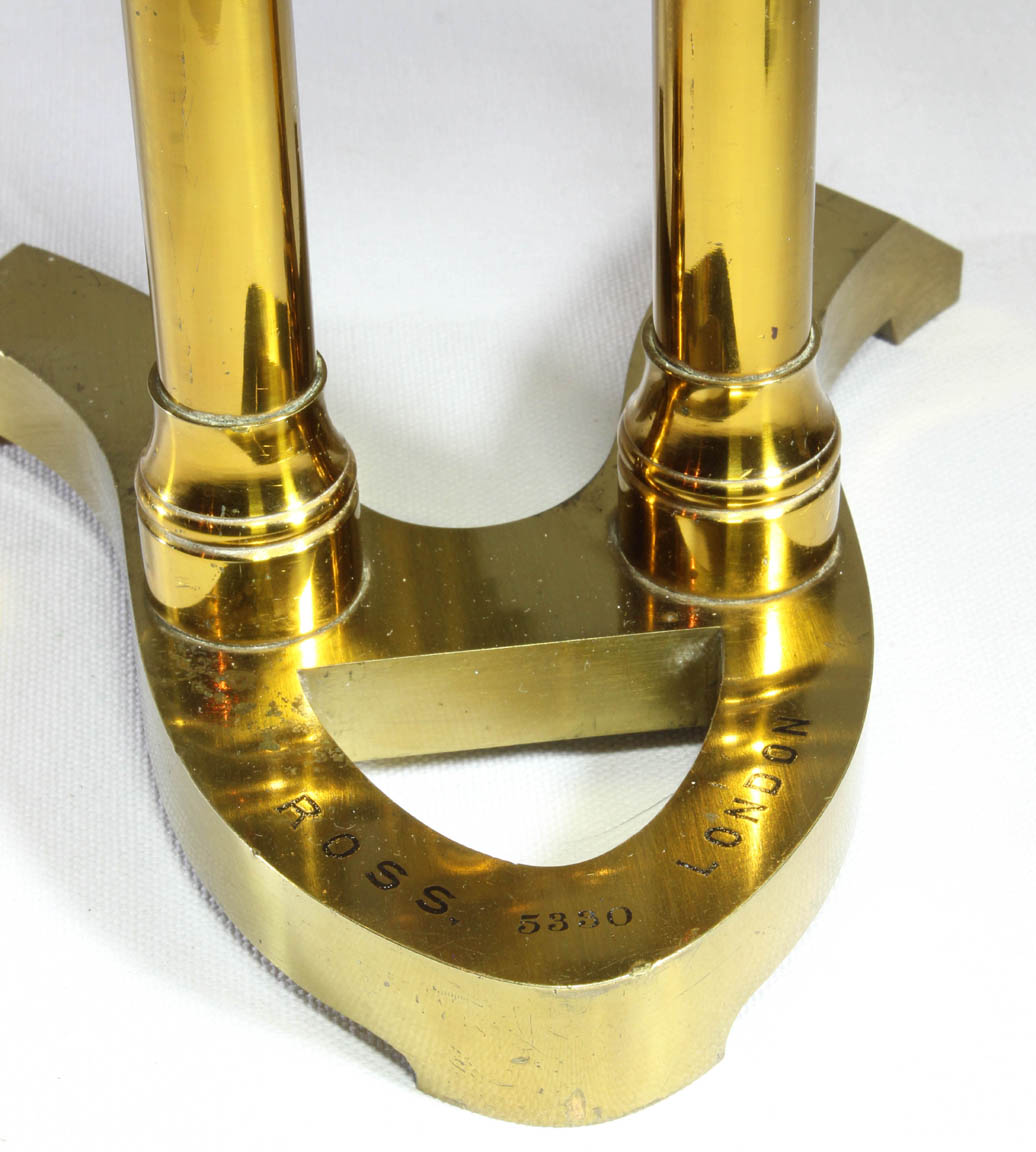
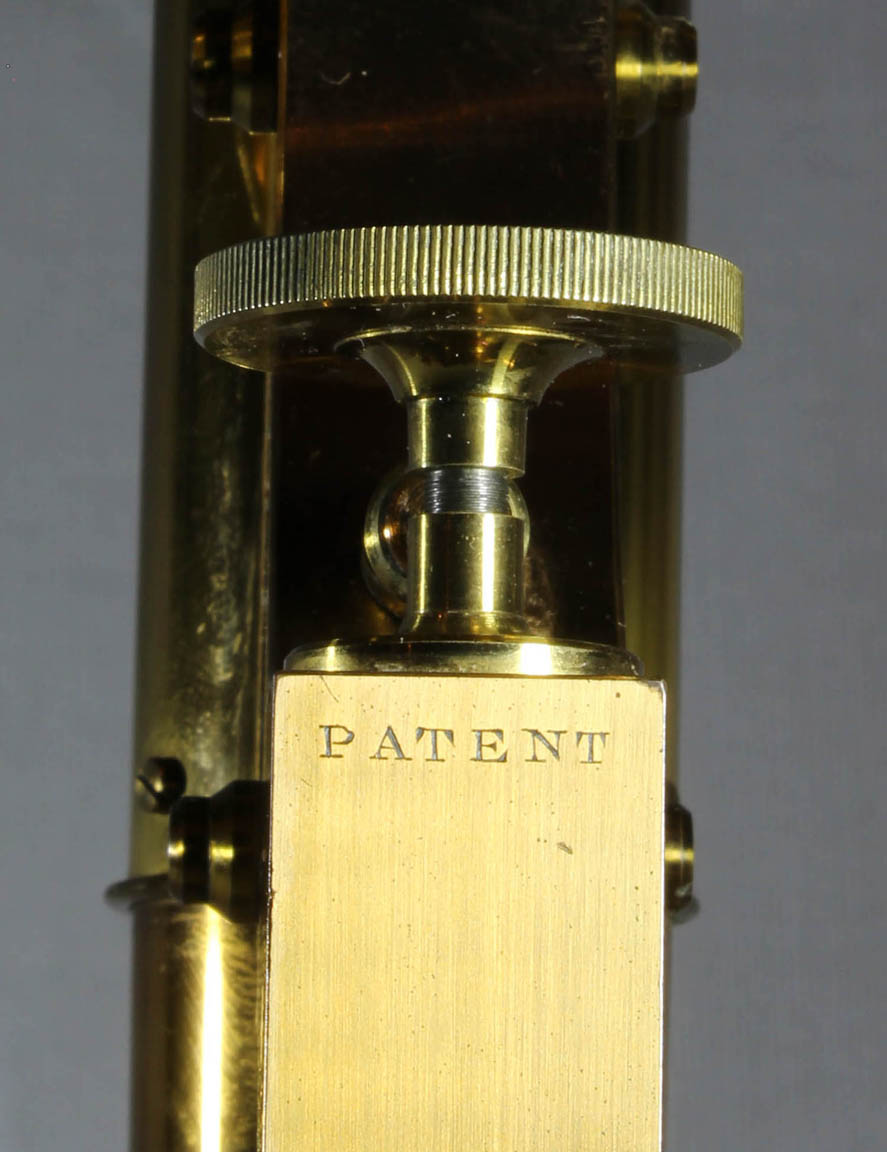 DESCRIPTION: This magnificent example of a Ross-Zentmayer stand arises from a lyre or 'A' shaped foot. The foot bears the words 'ROSS' and 'LONDON' surrounding the serial number of '5330'. Two round pillars support the trunion inclination joint which can be tightened in any position from vertical to horizontal via a tightening handle on the right side of the joint. There is a stop for the horizontal position. The Lister-Jackson limb supports an optical tube which has a coarse adjustment by diagonal rack and spiral pinion. The fine adjustment is via long lever within the limb controlled at the rear by a knurled knob. The fine focus knob is not graduated.
DESCRIPTION: This magnificent example of a Ross-Zentmayer stand arises from a lyre or 'A' shaped foot. The foot bears the words 'ROSS' and 'LONDON' surrounding the serial number of '5330'. Two round pillars support the trunion inclination joint which can be tightened in any position from vertical to horizontal via a tightening handle on the right side of the joint. There is a stop for the horizontal position. The Lister-Jackson limb supports an optical tube which has a coarse adjustment by diagonal rack and spiral pinion. The fine adjustment is via long lever within the limb controlled at the rear by a knurled knob. The fine focus knob is not graduated.
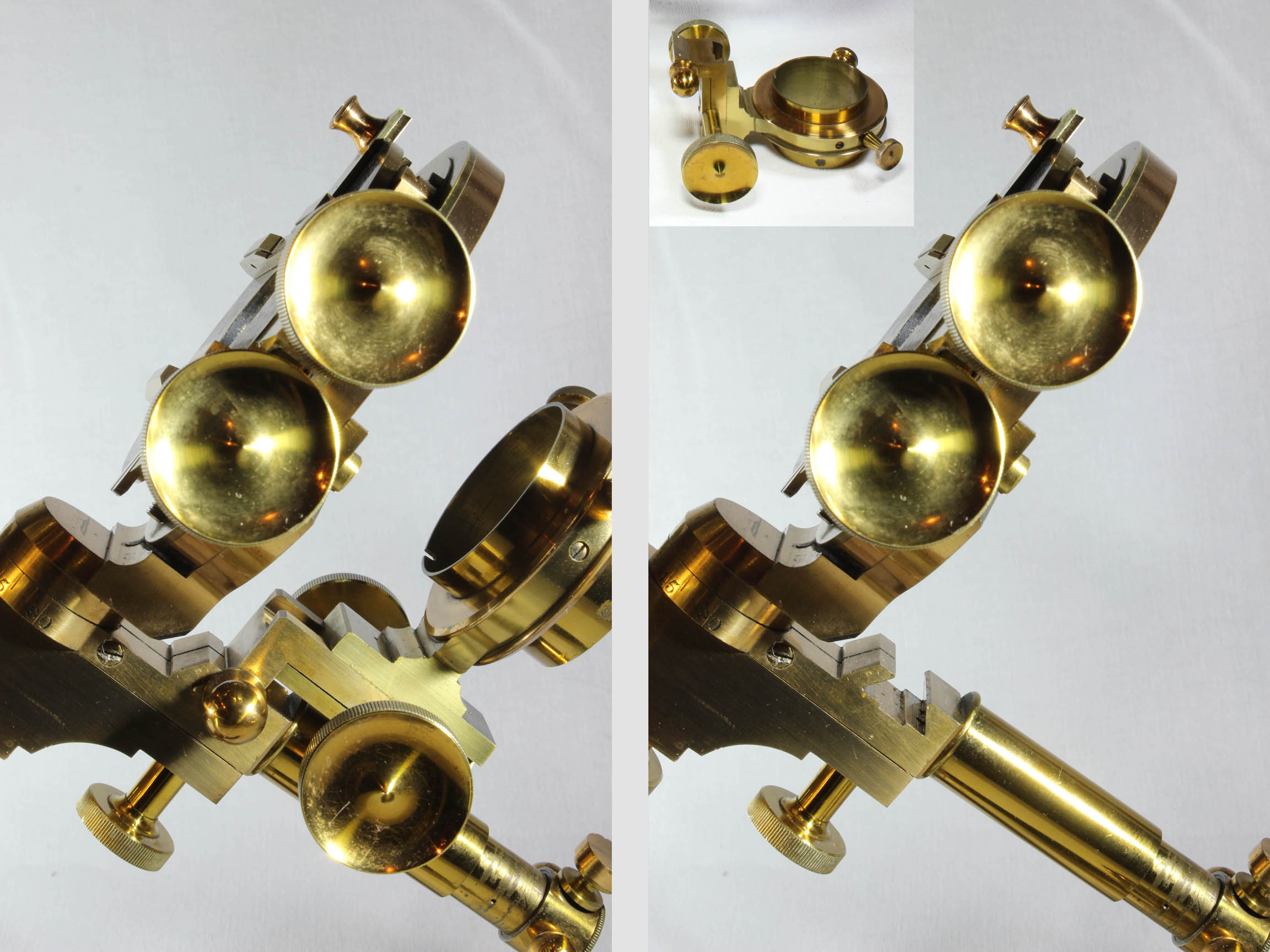 A conical pin passes through the limb to support the stage and swinging substage. The tension is easily adjusted via the knurled knob in the rear, so that any position selected can be secured. The substage assembly rides on a tailpiece that carries both the condenser assembly and the mirror. The ring at the top of the tailpiece is calibrated in 15 degree intervals, labelled every 45 degrees. The rack and pinion condenser assembly features adjustable centering via two knurled knobs but there is no geared rotation like that present on the binocular Ross-Zentmayer on this site.
The entire condenser assembly can easily be removed from the tailpiece by pulling it out of its dovetail fitting, using the brass knob. The gimbaled mirror has both flat and concave sides and is attached to a tube which slides up or down inside the tailpiece. The axis of rotation of the swinging substage is around the plane of the specimen which allows the focus of the condenser to be maintained regardless of the angle chosen. The tailpiece can be rigidly locked in the vertical position by a screw with knurled knob which passes through the limb at about the level of the dovetail fitting of the condenser assembly. The mechanical stage has controls for X and Y movement and the entire assembly can rotate around the stage. There is no calibration for this movement and this operation must be done manually as there is no gear-driven provision for this movement (in contrast to the binocular Ross-Zentmayer on this site).
A conical pin passes through the limb to support the stage and swinging substage. The tension is easily adjusted via the knurled knob in the rear, so that any position selected can be secured. The substage assembly rides on a tailpiece that carries both the condenser assembly and the mirror. The ring at the top of the tailpiece is calibrated in 15 degree intervals, labelled every 45 degrees. The rack and pinion condenser assembly features adjustable centering via two knurled knobs but there is no geared rotation like that present on the binocular Ross-Zentmayer on this site.
The entire condenser assembly can easily be removed from the tailpiece by pulling it out of its dovetail fitting, using the brass knob. The gimbaled mirror has both flat and concave sides and is attached to a tube which slides up or down inside the tailpiece. The axis of rotation of the swinging substage is around the plane of the specimen which allows the focus of the condenser to be maintained regardless of the angle chosen. The tailpiece can be rigidly locked in the vertical position by a screw with knurled knob which passes through the limb at about the level of the dovetail fitting of the condenser assembly. The mechanical stage has controls for X and Y movement and the entire assembly can rotate around the stage. There is no calibration for this movement and this operation must be done manually as there is no gear-driven provision for this movement (in contrast to the binocular Ross-Zentmayer on this site).
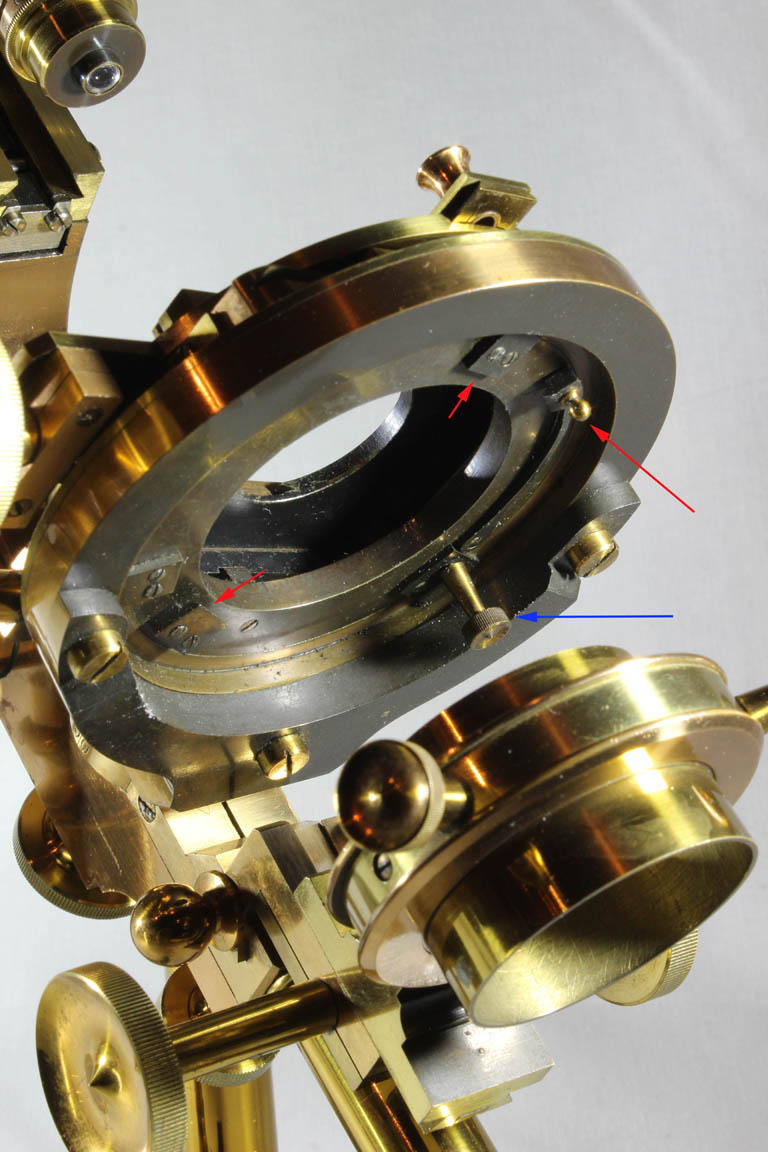 On the underside of the stage is a tension adjustment knob (blue arrow) for this rotation which can also be tightened to fix the rotation in any desired position. Also on the underside of the stage is a three point quick change fitting (red arrows) to allow direct attachment of accessories (such as a separate diaphragm) to the underside of the stage. The mechanical stage features a blackened surface and two slide holders, one sliding in from the front and the other from the back which not only grip the slide but allow it to be positioned as needed. The front slide holder has a receptacle for a stage forceps or other accessories. A hole in the side of the limb can also accomodate an accesory such as a side illuminator or condenser.
The main optical tube, without eyepiece or objective measures about 8 inches in length and the draw tube can extend the tube length to about 13 inches. There is a single eyepiece labelled 'D'. Currently the microscope is equipped with a single high power objective with correction collar.
On the underside of the stage is a tension adjustment knob (blue arrow) for this rotation which can also be tightened to fix the rotation in any desired position. Also on the underside of the stage is a three point quick change fitting (red arrows) to allow direct attachment of accessories (such as a separate diaphragm) to the underside of the stage. The mechanical stage features a blackened surface and two slide holders, one sliding in from the front and the other from the back which not only grip the slide but allow it to be positioned as needed. The front slide holder has a receptacle for a stage forceps or other accessories. A hole in the side of the limb can also accomodate an accesory such as a side illuminator or condenser.
The main optical tube, without eyepiece or objective measures about 8 inches in length and the draw tube can extend the tube length to about 13 inches. There is a single eyepiece labelled 'D'. Currently the microscope is equipped with a single high power objective with correction collar.
OPTIONAL FEATURES AND ACCESSORIES ON ROSS-ZENTMAYER STANDS:
The features lacking on this stand, which include calibration and geared rotation of the condenser housing, calibration of the rotation of the stage, calibrated scales for the X and Y movements, and geared rotation of the stage were all optional on all models of the Ross-Zentmayer microscopes according to the 1883 catalog. The Ross-Zentmayer microscopes were available in at least four different sizes, most as monocular or binocular. These were referred to in the Ross Catalog of 1883 as the 'Ross Zentmayer Microscope-stand' and were also called the 'No. 1 (or 2 or 3 or 4)Patent Microscope'. The stand was available with a choice of three different types of foot; these included the lyre-shaped foot seen on this and the other example in this collection, an 'English' (also called a 'Crouch' type) foot, as well as a continental 'horseshoe' foot. The number 1 was very large and is quite rarely seen today. The number 4 did not have rack and pinion control for the substage; in the number 4 the substage needed to be raised or lowered by pushing or pulling. Therefore the stand here is likely a number 3. All were available as monocular or binocular.
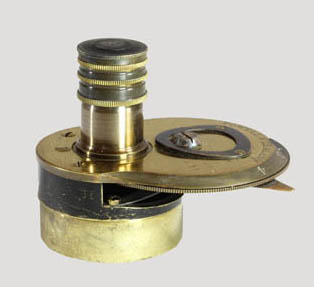
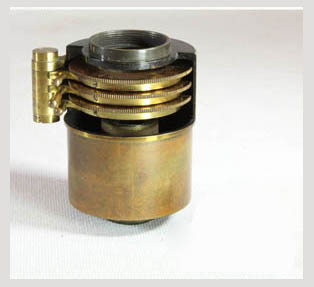 Accessories for the Ross-Zentmayer microscope, at least the size pictured here, are curiously lacking from the catalog offerings. For example some of the condensers offered in the 1883 catalog, although of the correct diameter, do not fit in the allotable vertical space for them-i.e. they are too long. Judging from the condenser usually supplied with the microscopes from the factory, as can be seen in the binocular example on this web site, those condensers specific to the Ross Zentmayer, at least of the size shown on this site, were not listed, but apparently simply included in the sale routinely. The example here now has a Powell and Lealand high power condenser (left), which can be used with oil immersion for high powers or with the top element removed for moderate powers. Another accessory that was offered in the catalog, and is now with the instrument, is a special polarizing condenser with swing-out selenites (right), which could be used singly or combined and are individually rotated. A nosepiece analyzer attaches to the nosepiece above the objective and can be rotated at will. This accessory was also offered in the catalog.
Accessories for the Ross-Zentmayer microscope, at least the size pictured here, are curiously lacking from the catalog offerings. For example some of the condensers offered in the 1883 catalog, although of the correct diameter, do not fit in the allotable vertical space for them-i.e. they are too long. Judging from the condenser usually supplied with the microscopes from the factory, as can be seen in the binocular example on this web site, those condensers specific to the Ross Zentmayer, at least of the size shown on this site, were not listed, but apparently simply included in the sale routinely. The example here now has a Powell and Lealand high power condenser (left), which can be used with oil immersion for high powers or with the top element removed for moderate powers. Another accessory that was offered in the catalog, and is now with the instrument, is a special polarizing condenser with swing-out selenites (right), which could be used singly or combined and are individually rotated. A nosepiece analyzer attaches to the nosepiece above the objective and can be rotated at will. This accessory was also offered in the catalog.
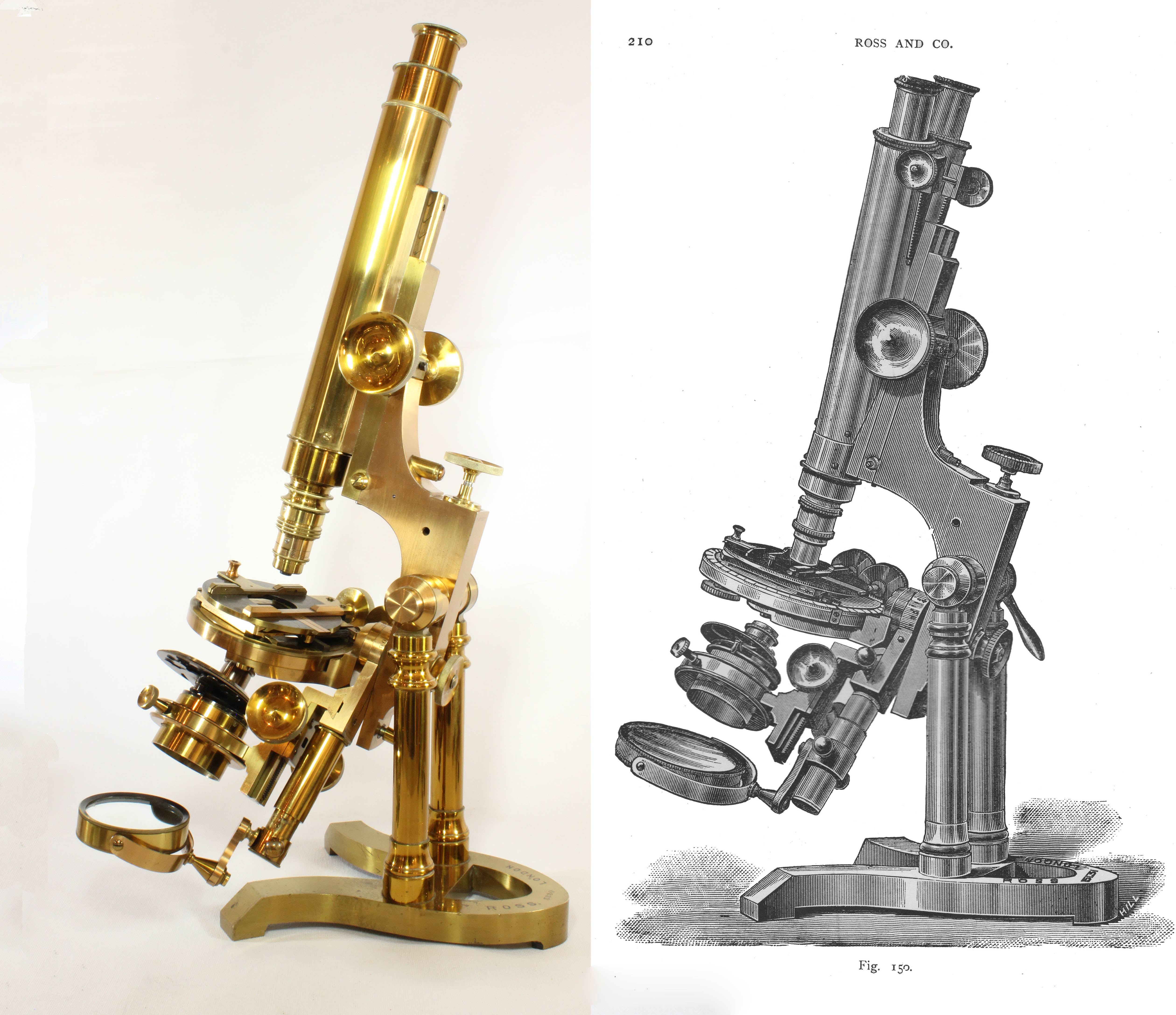 HISTORY OF ROSS-ZENTMAYER MICROSCOPES
HISTORY OF ROSS-ZENTMAYER MICROSCOPES
The firm of Andrew Ross dates back to the 1830's or earlier. In the achromatic era dating from about 1839, Ross soon became the most foremost maker of microscopes in England. His instruments were of high quality, and although sometimes not to the extreme standards of the small company of Powell and Lealand, his stands were more popular, less expensive and made in much greater numbers. When Andrew died, his son Thomas took over the business. When Thomas died in 1870, Francis Wenham was called upon to direct the further production of microscopes.
Wenham, primarily a marine engine and propeller engineer, also contributed greatly to early aviation theory and some of his work likely influenced the Wright Brothers. Among Wenhams accomplishments were his high pressure steam engines which were able to increase the speed of ships faster then the earlier low pressure steam. Wenham's constributions to microscopy were also quite extensive, so much so, that he was chosen to help guide the designs of the Ross company once Thomas Ross had died.
One of the major pursuits of microscopists of the last quarter of the nineteenth century (and before), was a desire to increase contrast and resolution. Before Abbe's theories were popularized one of the ways this was accomplished was via the use of oblique illumination via an angled light source below the stage. From this, it followed that the greater range of choices of oblique illumination, and the more extreme it could be, the more likely that a suitable arrangement could be acheived for optimal resolution and contrast of fine features of microscopical objects, especially diatoms. With the small diameter condensers of the time, extreme degrees of oblique illumination could only be achieved by illuminating from an angle rather than directly from below with the light parallel to the optical axis and perpendicular to the stage. The first person to popularize a method in which the swinging substage for this purpose did not have to be refocused as it swings, was the famous American microscope maker, Joseph Zentmayer. By having its axis of rotation at the plane of the slide, the focus was maintained throughout the range of obliquity. This feature soon became very popular and Francis Wenham quickly became one of its proponents in England. Additional important characteristics of this arrangement are the fact that the condenser had to be narrow enough to allow this and also that the stage was thin enough so as not to obstruct illumination from an extremely oblique angle. These became the essential features of the Ross-Zentmayer microscopes. The English patents for these were applied for in 1876 and 1877 and the Ross Zentmayer microscopes appeared in Ross catalogs as early as 1880.
Not only did Wenham come up with the Ross-Zentmayer models, but an even more complex stand which became known as the 'Wenham Radial' or the 'Ross Radial' an extremely rare microscope which was already obsolete when first produced. Wenham applied for the patent in the 'Radial' in 1881 and it was first produced in 1882. The inclusion of the swinging substage on microscopes soon faded as the newly introduced Abbe condensers with their much larger lenses appeared. The addition of a filter holder, moveable iris diaphragm, or both allowed oblique lighting to be easily achieved in these large lens condensers, without the swinging substage; either asymmetrical stops could be inserted in the filter holder, and/or the filter holder or iris could be offset to the edge of the optical path of the condenser so as to direct the light obliquely. The age of the swinging substage had come to an end.
In 1882, the first year of production of the 'Wenham Radial,' Francis Wenham became disenchanted with microscopy, having been embarassed by his erroneous and widely publicized disagreements with Robert Tolles. After 1882 Wenham no longer directed microscope development at Ross. The Ross-Zentmayer stands quickly gave way to more modern continental stands. By 1906 Ross was no longer making microscopes.
The author is very grateful to James Solliday, president of the Microscopical Society of Southern California for assistance in providing much of the information seen here concerning the history and techniques of oblique illumination.

 DESCRIPTION: This magnificent example of a Ross-Zentmayer stand arises from a lyre or 'A' shaped foot. The foot bears the words 'ROSS' and 'LONDON' surrounding the serial number of '5330'. Two round pillars support the trunion inclination joint which can be tightened in any position from vertical to horizontal via a tightening handle on the right side of the joint. There is a stop for the horizontal position. The Lister-Jackson limb supports an optical tube which has a coarse adjustment by diagonal rack and spiral pinion. The fine adjustment is via long lever within the limb controlled at the rear by a knurled knob. The fine focus knob is not graduated.
DESCRIPTION: This magnificent example of a Ross-Zentmayer stand arises from a lyre or 'A' shaped foot. The foot bears the words 'ROSS' and 'LONDON' surrounding the serial number of '5330'. Two round pillars support the trunion inclination joint which can be tightened in any position from vertical to horizontal via a tightening handle on the right side of the joint. There is a stop for the horizontal position. The Lister-Jackson limb supports an optical tube which has a coarse adjustment by diagonal rack and spiral pinion. The fine adjustment is via long lever within the limb controlled at the rear by a knurled knob. The fine focus knob is not graduated. A conical pin passes through the limb to support the stage and swinging substage. The tension is easily adjusted via the knurled knob in the rear, so that any position selected can be secured. The substage assembly rides on a tailpiece that carries both the condenser assembly and the mirror. The ring at the top of the tailpiece is calibrated in 15 degree intervals, labelled every 45 degrees. The rack and pinion condenser assembly features adjustable centering via two knurled knobs but there is no geared rotation like that present on the binocular Ross-Zentmayer on this site.
The entire condenser assembly can easily be removed from the tailpiece by pulling it out of its dovetail fitting, using the brass knob. The gimbaled mirror has both flat and concave sides and is attached to a tube which slides up or down inside the tailpiece. The axis of rotation of the swinging substage is around the plane of the specimen which allows the focus of the condenser to be maintained regardless of the angle chosen. The tailpiece can be rigidly locked in the vertical position by a screw with knurled knob which passes through the limb at about the level of the dovetail fitting of the condenser assembly. The mechanical stage has controls for X and Y movement and the entire assembly can rotate around the stage. There is no calibration for this movement and this operation must be done manually as there is no gear-driven provision for this movement (in contrast to the binocular Ross-Zentmayer on this site).
A conical pin passes through the limb to support the stage and swinging substage. The tension is easily adjusted via the knurled knob in the rear, so that any position selected can be secured. The substage assembly rides on a tailpiece that carries both the condenser assembly and the mirror. The ring at the top of the tailpiece is calibrated in 15 degree intervals, labelled every 45 degrees. The rack and pinion condenser assembly features adjustable centering via two knurled knobs but there is no geared rotation like that present on the binocular Ross-Zentmayer on this site.
The entire condenser assembly can easily be removed from the tailpiece by pulling it out of its dovetail fitting, using the brass knob. The gimbaled mirror has both flat and concave sides and is attached to a tube which slides up or down inside the tailpiece. The axis of rotation of the swinging substage is around the plane of the specimen which allows the focus of the condenser to be maintained regardless of the angle chosen. The tailpiece can be rigidly locked in the vertical position by a screw with knurled knob which passes through the limb at about the level of the dovetail fitting of the condenser assembly. The mechanical stage has controls for X and Y movement and the entire assembly can rotate around the stage. There is no calibration for this movement and this operation must be done manually as there is no gear-driven provision for this movement (in contrast to the binocular Ross-Zentmayer on this site).  On the underside of the stage is a tension adjustment knob (blue arrow) for this rotation which can also be tightened to fix the rotation in any desired position. Also on the underside of the stage is a three point quick change fitting (red arrows) to allow direct attachment of accessories (such as a separate diaphragm) to the underside of the stage. The mechanical stage features a blackened surface and two slide holders, one sliding in from the front and the other from the back which not only grip the slide but allow it to be positioned as needed. The front slide holder has a receptacle for a stage forceps or other accessories. A hole in the side of the limb can also accomodate an accesory such as a side illuminator or condenser.
The main optical tube, without eyepiece or objective measures about 8 inches in length and the draw tube can extend the tube length to about 13 inches. There is a single eyepiece labelled 'D'. Currently the microscope is equipped with a single high power objective with correction collar.
On the underside of the stage is a tension adjustment knob (blue arrow) for this rotation which can also be tightened to fix the rotation in any desired position. Also on the underside of the stage is a three point quick change fitting (red arrows) to allow direct attachment of accessories (such as a separate diaphragm) to the underside of the stage. The mechanical stage features a blackened surface and two slide holders, one sliding in from the front and the other from the back which not only grip the slide but allow it to be positioned as needed. The front slide holder has a receptacle for a stage forceps or other accessories. A hole in the side of the limb can also accomodate an accesory such as a side illuminator or condenser.
The main optical tube, without eyepiece or objective measures about 8 inches in length and the draw tube can extend the tube length to about 13 inches. There is a single eyepiece labelled 'D'. Currently the microscope is equipped with a single high power objective with correction collar.

 Accessories for the Ross-Zentmayer microscope, at least the size pictured here, are curiously lacking from the catalog offerings. For example some of the condensers offered in the 1883 catalog, although of the correct diameter, do not fit in the allotable vertical space for them-i.e. they are too long. Judging from the condenser usually supplied with the microscopes from the factory, as can be seen in the binocular example on this web site, those condensers specific to the Ross Zentmayer, at least of the size shown on this site, were not listed, but apparently simply included in the sale routinely. The example here now has a Powell and Lealand high power condenser (left), which can be used with oil immersion for high powers or with the top element removed for moderate powers. Another accessory that was offered in the catalog, and is now with the instrument, is a special polarizing condenser with swing-out selenites (right), which could be used singly or combined and are individually rotated. A nosepiece analyzer attaches to the nosepiece above the objective and can be rotated at will. This accessory was also offered in the catalog.
Accessories for the Ross-Zentmayer microscope, at least the size pictured here, are curiously lacking from the catalog offerings. For example some of the condensers offered in the 1883 catalog, although of the correct diameter, do not fit in the allotable vertical space for them-i.e. they are too long. Judging from the condenser usually supplied with the microscopes from the factory, as can be seen in the binocular example on this web site, those condensers specific to the Ross Zentmayer, at least of the size shown on this site, were not listed, but apparently simply included in the sale routinely. The example here now has a Powell and Lealand high power condenser (left), which can be used with oil immersion for high powers or with the top element removed for moderate powers. Another accessory that was offered in the catalog, and is now with the instrument, is a special polarizing condenser with swing-out selenites (right), which could be used singly or combined and are individually rotated. A nosepiece analyzer attaches to the nosepiece above the objective and can be rotated at will. This accessory was also offered in the catalog.
 HISTORY OF ROSS-ZENTMAYER MICROSCOPES
HISTORY OF ROSS-ZENTMAYER MICROSCOPES